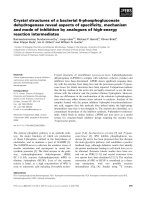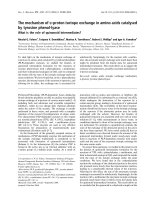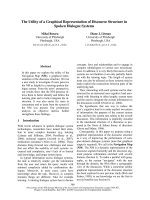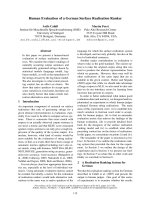Báo cáo khoa học: "Dramatic response of a gastrointestinal stromal tumor to neadjuvant imatinib therapy" pptx
Bạn đang xem bản rút gọn của tài liệu. Xem và tải ngay bản đầy đủ của tài liệu tại đây (662.58 KB, 3 trang )
BioMed Central
Page 1 of 3
(page number not for citation purposes)
World Journal of Surgical Oncology
Open Access
Case report
Dramatic response of a gastrointestinal stromal tumor to
neadjuvant imatinib therapy
Shohrat Annaberdyev
1
, Joseph Gibbons
1,2
and Jeffrey M Hardacre*
1,3
Address:
1
Case Western Reserve University School of Medicine, Cleveland, Ohio, USA,
2
Division of Hematology/Oncology, University Hospitals
Case Medical Center, Cleveland, Ohio, USA and
3
Division of Surgical Oncology, University Hospitals Case Medical Center, Cleveland, Ohio, USA
Email: Shohrat Annaberdyev - ; Joseph Gibbons - ;
Jeffrey M Hardacre* -
* Corresponding author
Abstract
Gastrointestinal stromal tumors (GISTs) are the most common sarcoma of the alimentary tract
and are believed to derive from the interstitial Cell of Cajal. Imatinib mesylate (Gleevec
®
; Novartis,
Basel, Switzerland) has revolutionized the treatment of GISTs and is generally used in the
metastatic and adjuvant settings. We report the case of a 61-year old man who was treated with
neoadjuvant imatinib for a massive gastric GIST with the hope of avoiding a potential multi-visceral
resection.
Case presentation
A 61-year old man presented with a left upper quadrant
abdominal mass after experiencing several intermittent
episodes of nausea, vague abdominal discomfort, and
mild acid reflux. He also reported a nine kilogram weight
loss over the prior six to eight months. Physical examina-
tion revealed a large mass in his upper abdomen.
Abdominal computed tomography (CT) revealed a 21 ×
12 cm heterogeneous mass occupying his mid and left
upper quadrants (Figure 1). Based on its location and
imaging characteristics, the mass was hypothesized to be
a GIST. The differential also included lymphoma, retro-
peritoneal sarcoma, and, less likely, a pancreatic neo-
plasm. To establish the diagnosis, an endoscopic
ultrasound was performed and a core biopsy of the mass
was obtained. The pathology of the core biopsy classified
the mass as a spindle cell neoplasm that stained positive
for CD117, consistent with a GIST.
Given the size and location of the lesion at the time of ini-
tial evaluation, resection of the mass would likely have
necessitated a multi-visceral resection. Based on recent
reports of effective preoperative imatinib therapy, a trial
of neoadjuvant imatinib was felt to be the optimal treat-
ment strategy to down-stage the tumor and minimize the
extent of resection [1].
The patient was treated with imatinib and tolerated the
therapy well, with the exception of developing mild peri-
orbital edema, the most commonly reported side effect of
imatinib [2]. He was followed with CT scans performed at
two-month intervals. The mass measured 21 × 12 cm on
initial imaging. Subsequent measurements were 16.9 ×
9.1 cm, 12.2 × 9.6 cm, and 10 × 8 cm (Figure 2) at two,
four, and six month intervals, respectively. Upon review-
ing the patient's imaging and clinical course after six
months of treatment, it was felt that resection was appro-
priate. Further, there was concern regarding the develop-
ment of secondary resistance to imatinib.
Published: 16 March 2009
World Journal of Surgical Oncology 2009, 7:30 doi:10.1186/1477-7819-7-30
Received: 2 December 2008
Accepted: 16 March 2009
This article is available from: />© 2009 Annaberdyev et al; licensee BioMed Central Ltd.
This is an Open Access article distributed under the terms of the Creative Commons Attribution License ( />),
which permits unrestricted use, distribution, and reproduction in any medium, provided the original work is properly cited.
World Journal of Surgical Oncology 2009, 7:30 />Page 2 of 3
(page number not for citation purposes)
The patient was counseled regarding a likely partial gast-
rectomy but also informed that a total gastrectomy and
even a multi-visceral resection may be needed. At opera-
tion, he was found to have a softball-sized mass attached
by a stalk to his stomach. He underwent a wedge resection
of his stomach that included the stalk and tumor en bloc.
Pathological analysis revealed a tumor of 15 cm in great-
est dimension. There were extensive areas of ischemic
necrosis. There were up to two mitoses per 50 high-power
fields. The margins of the gastric resection were free of
neoplasm.
The patient recovered from the operation. At least one
year of adjuvant imatinib therapy is planned.
Discussion
GISTs are the most common sarcoma of the gastrointesti-
nal tract. GISTs are characterized by the expression of the
cell surface marker CD117, which is found in 95–100% of
GISTs [3]. CD117 is a receptor tyrosine kinase, coded for
by the c-kit proto-oncogene. Overexpression of this gene
is most commonly caused by an activating mutation of
exon 11 and is hypothesized to be responsible for GIST
oncogenesis [4].
Historically, GISTs have responded very poorly to radia-
tion and cytotoxic chemotherapy, making surgical resec-
tion the only effective treatment. Imatinib, a receptor
tyrosine kinase inhibitor, was first used in the treatment of
chronic myelogenous leukemia, which is characterized by
the constitutive activation of the Bcr-Abl tyrosine kinase
[5]. Imatinib's effect is mediated by its ability to bind to
the ATP-binding site on the tyrosine kinase, thus prevent-
ing its function.
The first report of imatinib in the treatment of GIST was
published in 2001 by Joensuu et al [6]. Since then, multi-
ple studies have confirmed the usefulness of imatinib
therapy in treating GISTs, leading to FDA approval of
imatinib in the treatment of metastatic and/or unresecta-
ble GISTs [7]. Notably, Demetri et al conducted a study of
147 patients who received either 400 or 600 mg of imat-
inib daily. They reported a 54% radiographic response in
their patient population [2].
The most common side effects of imatinib are fluid reten-
tion, diarrhea, nausea, fatigue, muscle cramps, abdominal
pain, and rash. Extremity a facial edema (the latter was
experienced by the patient in this case) were the most fre-
quent adverse effects in the Demetri study.
A new approach is evolving that relies on neoadjuvant
imatinib to down-stage the tumor in cases of advanced
GISTs. Prior studies have described patients with inopera-
ble or metastatic GISTs who underwent treatment with
imatinib and had a dramatic response allowing surgical
resection [8,9].
The median time for an objective response to imatinib is
four months, but maximal response is reported to take six
months or longer [10]. Response is defined as absence of
progression at the time of first follow-up, generally two-
Follow up CT scan after six months of ImatinibFigure 2
Follow up CT scan after six months of Imatinib. The
tumor has shrunk to 10 × 8 cm.
Initial CT scan revealing an abdominal mass measuring 21 × 12 cmFigure 1
Initial CT scan revealing an abdominal mass measur-
ing 21 × 12 cm.
Publish with BioMed Central and every
scientist can read your work free of charge
"BioMed Central will be the most significant development for
disseminating the results of biomedical research in our lifetime."
Sir Paul Nurse, Cancer Research UK
Your research papers will be:
available free of charge to the entire biomedical community
peer reviewed and published immediately upon acceptance
cited in PubMed and archived on PubMed Central
yours — you keep the copyright
Submit your manuscript here:
/>BioMedcentral
World Journal of Surgical Oncology 2009, 7:30 />Page 3 of 3
(page number not for citation purposes)
three months after starting therapy. The patient in our case
was believed to have achieved sufficient response to allow
for an uncomplicated, successful resection of the GIST.
While most patients respond to imatinib, many eventu-
ally develop resistance. Initial (primary) resistance is
defined as progression of disease at the time of first follow
up after start of therapy [11]. These patients are not
responsive to imatinib. Late (secondary) resistance is seen
in a patient who experiences disease progression after a
period of response. Patients who respond should be fol-
lowed with serial imaging. Ideally, resection should be
performed before the development of resistance.
The role of imatinib in the neoadjuvant setting is illus-
trated in this case. While the GIST found in this patient
may not have been inoperable before imatinib treatment,
the procedure may have required a multi-visceral resec-
tion. Neoadjuvant imatinib was given and after dramatic
radiographic response, a simple wedge gastric resection
was needed.
Surgeons should consider the use of neoadjuvant imat-
inib therapy in patients with marginally resectable GISTs.
A response to imatinib can allow for a less extensive
though still therapeutic oncologic resection.
Competing interests
The authors declare that they have no competing interests.
Authors' contributions
SA drafted the manuscript. JG reviewed an amended the
manuscript. JMH reviewed and amended the manuscript.
All authors read and approved the final manuscript.
References
1. Andtbacka RH, Ng CS, Scaife CL, Cormier JN, Hunt KK, Pisters PW,
Pollock RE, Benjamin RS, Burgess MA, Chen LL, Trent J, Patel SR, Ray-
mond K, Feig BW: Surgical resection of gastrointestinal stro-
mal tumors after treatment with imatinib. Ann Surg Oncol
2007, 14:14-24.
2. Demetri GD, von Mehren M, Blanke CD, Abbeele AD Van den, Eisen-
berg B, Roberts PJ, Heinrich MC, Tuveson DA, Singer S, Janicek M,
Fletcher JA, Silverman SG, Silberman SL, Capdeville R, Kiese B, Peng
B, Dimitrijevic S, Druker BJ, Corless C, Fletcher CD, Joensuu H: Effi-
cacy and safety of imatinib mesylate in advanced gastrointes-
tinal stromal tumors. N Engl J Med 2002, 347:472-80.
3. Sarlomo-Rikala M, Kovatich AJ, Barusevicius A, Miettinen M: CD117:
a sensitive marker for gastrointestinal stromal tumors that
is more specific than CD34. Mod Pathol 1998, 11:728-734.
4. Andersson J, Sjogren H, Meis-Kindblom JM, Stenman G, Aman P,
Kindblom LG: The complexity of KIT gene mutations and
chromosome rearrangements and their clinical correlation
in gastrointestinal stromal (pacemaker cell) tumors. Am J
Pathol 2002, 160:15-22.
5. Savage DG, Antman KH: Imatinib mesylate – a new oral tar-
geted therapy. N Eng J Med 2002, 346:683-693.
6. Joensuu H, Roberts PJ, Sarlomo-Rikala M, Andersson LC, Tervahar-
tiala P, Tuveson D, Silberman S, Capdeville R, Dimitrijevic S, Druker
B, Demetri GD: Effect of the tyrosine kinase inhibitor STI571
in a patient with a metastatic gastrointestinal stromal
tumor. N Eng J Med 2001, 344:1052-1056.
7. Dagher R, Cohen M, Williams G, Rothmann M, Gobburu J, Robbie G,
Rahman A, Chen G, Staten A, Griebel D, Pazdur R: Approval Sum-
mary: Imatinib mesylate in the treatment of metastatic and/
or unresectable malignant gastrointestinal stromal tumors.
Clin Cancer Res 2002, 8:3034-3038.
8. Grochi A, Fiore M, Miselli F, Lagonigro MS, Coco P, Messina A, Pilotti
S, Casali PG: Surgery of residual disease following molecular-
targeted therapy with Imatinib mesylate in advanced/meta-
static GIST. Ann Surg 2007, 245:341-346.
9. DeMatteo RP, Maki RG, Singer S, Gonen M, Brennan MF, Antonescu
CR: Results of tyrosine kinase inhibitor therapy followed by
surgical resection for metastatic gastrointestinal stromal
tumor. Ann Surg 2007, 245:347-352.
10. Verweij J, Casali PG, Zalcberg J, LeCesne A, Reichardt A, Blay JY,
Issels R, van Oosterom A, Hogendoorn PC, Van Glabbeke M, Bertulli
R, Judson I: Progression-free survival in gastrointestinal stro-
mal tumours with high-dose imatinib: randomized trial. Lan-
cet 2004, 364:1127-1134.
11. Van Glabbeke M, Verweij J, Casali PG, Le Cesne A, Hohenberger P,
Ray-Coquard I, Schlemmer M, van Oosterom AT, Goldstein D, Sciot
R, Hogendoorn PCW, Brown M, Bertulli R, Judson IR: Initial and
late resistance to Imatinib in advanced gastrointestinal stro-
mal tumors are predicted by different prognostic factors: A
European Organisation for Research and Treatments of
Cancer-Italian Sarcoma Group-Australasian Gastrointesti-
nal Trials Group Study. J Clin Oncol 2005, 23:5795-5804.







![Tài liệu Báo cáo khoa học: Specific targeting of a DNA-alkylating reagent to mitochondria Synthesis and characterization of [4-((11aS)-7-methoxy-1,2,3,11a-tetrahydro-5H-pyrrolo[2,1-c][1,4]benzodiazepin-5-on-8-oxy)butyl]-triphenylphosphonium iodide doc](https://media.store123doc.com/images/document/14/br/vp/medium_vpv1392870032.jpg)

